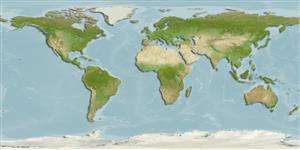Actinopterygii (ray-finned fishes) >
Gobiesociformes (Clingfishes) >
Gobiesocidae (Clingfishes and singleslits) > Gobiesocinae
Etymology: Diplocrepis: Greek, diploos = twice + Greek, krepis, idos = base, foundation (Ref. 45335).
Environment / Climate / Range
Ecology
Marine; demersal; depth range 0 - 15 m (Ref. 9003). Temperate, preferred ?
Southwest Pacific: endemic to New Zealand.
Size / Weight / Age
Maturity: Lm ? range ? - ? cm
Max length : 12.5 cm SL male/unsexed; (Ref. 9003); common length : 8.5 cm SL male/unsexed; (Ref. 9003)
Short description
Morphology | Morphometrics
Dorsal
spines
(total): 0;
Dorsal
soft rays
(total): 10-11;
Anal
spines: 0;
Anal
soft rays: 4 - 5. Olive pink or green to brown, red, yellow or lilac, with or without stripes, spots or bars. Breeding males with pinkish dorsal saddle. Distinguished from other clingfishes by the large, rounded head with incisorform teeth and a large, blunt posteriorly projecting spine at the lower margin of the operculum.
Common in rock pools at low tide and sub-tidally. Found clinging under rocks or boulders in more sheltered areas. Feeds on amphipods, gastropods, and fishes. Takes cover when disturbed.
Eggs are guarded by the male.
Paulin, C. and C. Roberts, 1992. The rockpool fishes of New Zealand (Te ika aaria o Aotearoa). Museum of New Zealand (Te Papa Tongarewa). 177 p. (Ref. 9003)
IUCN Red List Status (Ref. 115185)
CITES (Ref. 94142)
Not Evaluated
Threat to humans
Harmless
Human uses
More information
Age/SizeGrowthLength-weightLength-lengthLength-frequenciesMorphometricsMorphologyLarvaeLarval dynamicsRecruitmentAbundance
ReferencesAquacultureAquaculture profileStrainsGeneticsAllele frequenciesHeritabilityDiseasesProcessingMass conversion
Tools
Special reports
Download XML
Internet sources
